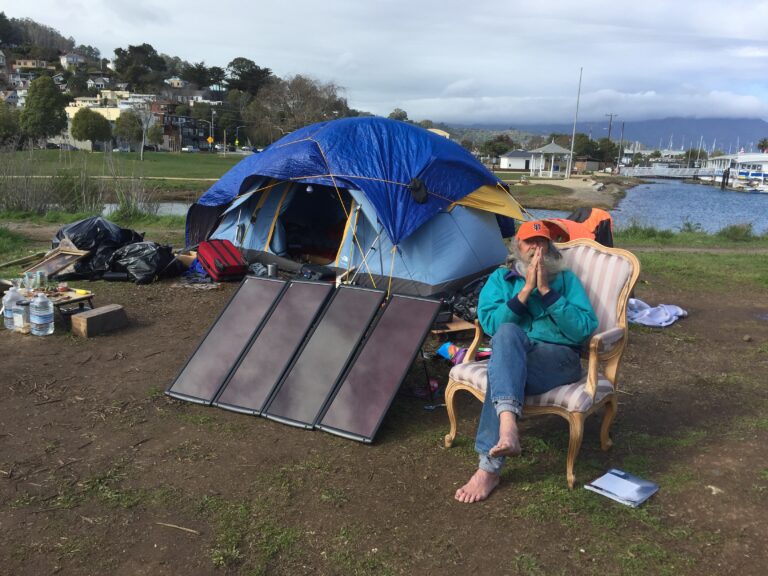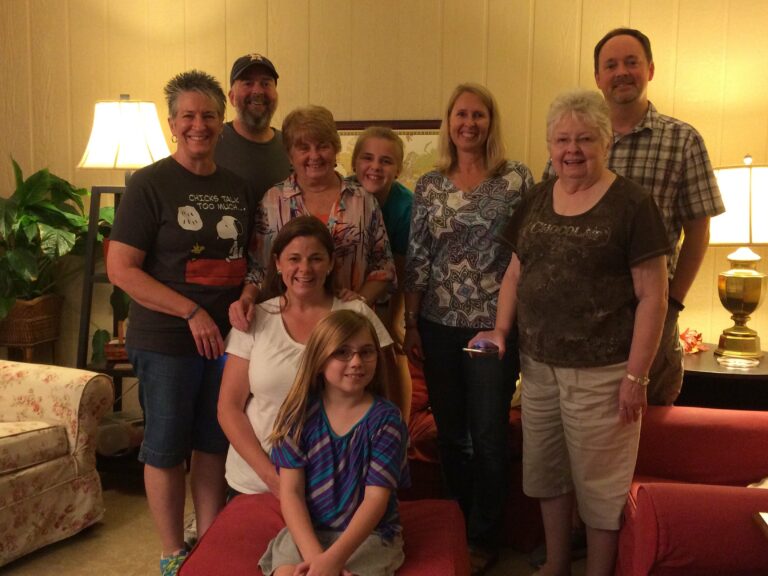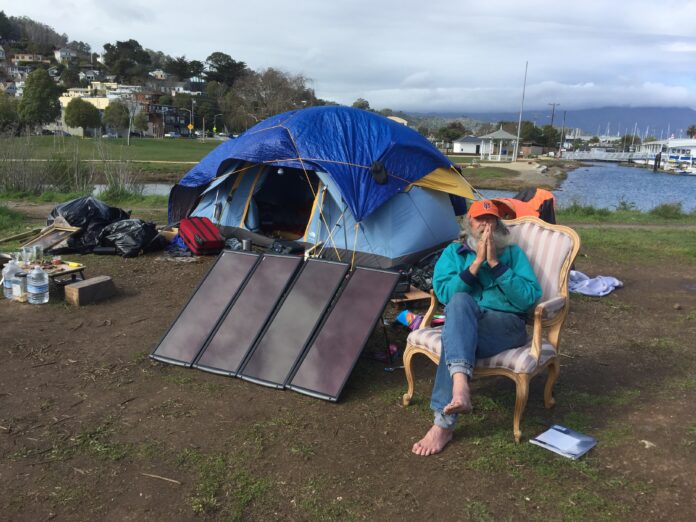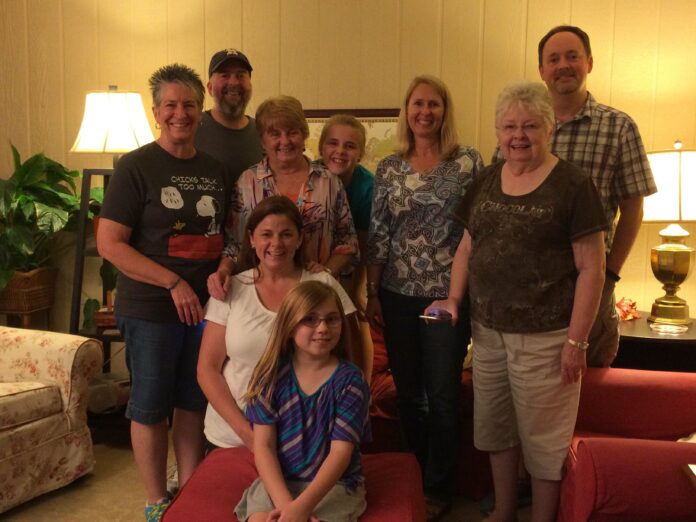After 18 months of contentious litigation between the City of Sausalito and the Sausalito Homeless Union, both parties have confirmed they are in the process of negotiating a settlement.
The Homeless Union filed the lawsuit in federal court in February 2021, just days after the Sausalito City Council passed a restrictive anti-camping ordinance in response to a new homeless encampment that sprang up near a downtown park.
The ordinance also required moving the campers from the visible waterfront location to a city-sanctioned camp in Marinship Park, located in a light industrial area. Nineteen people currently live on the Marinship tennis courts, down from a high of about 45.
The encampment population has dwindled in recent months due to attrition and the city’s policy of preventing new people from moving in. Police Lieutenant Stacie Gregory, who said last month that she spends 75% of her time on the encampment, is often seen on the tennis courts directing city staff to remove a tent after someone has moved out.
There have been no exceptions—not even for John Burke, who is undergoing experimental chemotherapy treatments for cancer. Burke says he needs a place to live because his former home, a boat anchored out in Richardson Bay, was seized and crushed by the Richardson Bay Regional Agency while he was in the hospital.
The police have escorted Burke out of the encampment on several occasions. When Burke moved into a recently vacated tent, Gregory and her crew removed it after he left for a chemo appointment.
With the camp shrinking in size, it’s unclear why Sausalito has now decided to engage in settlement discussions with the Homeless Union. Until now, the city has used a take-no-prisoners approach with the litigation, the encampment and the homeless residents. Most efforts by the Homeless Union to negotiate even small issues have been rebuffed.
Sausalito Mayor Janelle Kellman has shed no light on what precipitated the change in tactics.
“The City of Sausalito is engaged in confidential settlement negotiations with the Sausalito Homeless Union as part of the pending litigation,” Kellman said. “The city is not permitted to reveal the content of those discussions.”
Anthony Prince, attorney for the Homeless Union, has always been straightforward about what his clients are seeking from Sausalito. It boils down to people getting people housed.
“The city has to pay for durable housing for everyone in that encampment,” Prince said. “We’re getting close to an agreement, I think. There are still some things to work out, but I am cautiously optimistic.
While Sausalito’s budget is currently running at a deficit, which City Manager Chris Zapata attributes to “unplanned expenses related to homelessness” and pension costs, last week the city council approved an expenditure of $745,461 for encampment management services from Five Keys, a nonprofit organization.
That vote almost derailed settlement negotiations, according to Prince. Indeed, having an outside contractor manage the camp has been problematic for the Marinship residents in the past.
Urban Alchemy, a San Francisco-based nonprofit, performed those duties on and off since February 2021. Most of Urban Alchemy’s employees were formerly incarcerated, having “served life sentences in prison,” according to its website.
In June, the Sausalito campers alleged that Urban Alchemy staff had sexually exploited homeless females, used and distributed drugs on the job, and stolen property from the campers. The city refused to terminate the contract with Urban Alchemy early, even though it was scheduled to end two weeks later.
Five Keys also hires formerly incarcerated people. Prince believes the city’s approval to enter into a contract with Five Keys was intended to frighten and intimidate the campers, despite the fact that the organization has a solid reputation.
“We’re against that company having anything to do with the camp,” Prince said. “Since Urban Alchemy left, the camp is more peaceful than it’s ever been.”
This month, the city hired licensed security guards from a private firm to watch over the encampment. The campers say the guards treat them with respect.
Sausalito has repeatedly indicated that it wants to close the camp. Alex Merrit, an attorney representing the city, brought up the topic at a hearing in federal court last month. A city staff report issued last week about hiring Five Keys states the contract “is to speed unhoused persons to housing and close the temporary Marinship shelter.”
Since the encampment’s inception in late 2020, 10 people have been housed by the County of Marin and one through the U.S. Department of Veterans Affairs. Sausalito hasn’t provided any housing, although it has spent more than $1.5 million on expenses related to the encampment, mostly for legal fees and Urban Alchemy.
The county, which receives state and federal funding to provide services and housing for homeless people, has a long waiting list for permanent supportive housing and Section 8 housing vouchers. Yet, Sausalito’s leaders claim Five Keys will be able to hurry housing for the campers by collaborating with the county.
The county is engaged with homeless people in Sausalito and across Marin, according to Gary Naja-Riese, director of Marin County’s Division of Homelessness. The department provides regular updates to Sausalito on the status of its work in the city.
“We have 89% engagement through outreach or case management with the people in the Sausalito encampment,” Naja-Riese said. “That means there’s two people we’re not engaging with right now.”
Still, the city council authorized paying Five Keys almost $750,000 for six months of services. A city staff report stated the cost will be subsidized by a $500,000 allocation from Marin County. The mayor also made an announcement at the city council last week about the funding and confirmed it in an email to the Pacific Sun.
However, the county has not allocated $500,000 to Sausalito, Naja-Riese said. The county recently submitted a joint proposal to the state for $1.5 million. If awarded, Sausalito, San Rafael and Novato would each receive $500,000 for encampment expenses in their cities. There has been discussion of the county providing matching funds, though it is predicated upon receiving the state money and requires approval by the board of supervisors.
It appears Sausalito is counting its chickens before they’re hatched, which isn’t wise when the city already has a budget deficit. That’s not the only problem besetting the city right now.
The Sausalito police department is having personnel issues. Chief John Rohrbacher and Captain Bill Fraass are out of the office indefinitely, according to a source who spoke on the condition of anonymity. Kellman, Sausalito’s mayor, said Lieutenant Stacie Gregory is the acting chief and declined to provide additional information.
Hopefully, Sausalito can secure funding to work out the settlement that Prince wants for his clients—chiefly, housing. After housing is found for the people on the tennis courts, the city intends to close the camp. Then, what’s next? Is Sausalito going to build a border wall to keep other homeless people from entering the city limits?
Martin v. Boise, a 2018 decision by the Ninth Circuit Court of Appeals, states cities must allow homeless people to sleep on public property unless it can provide them with an appropriate alternative shelter option. There are far more homeless people in the county than shelter beds.
Sausalito’s current anti-camping ordinance does not permit homeless people to sleep on public property, except at the city-sanctioned encampment in Marinship. Once it’s closed, should the city choose to enforce the ordinance, there will be nowhere for a homeless person to sleep, which certainly violates Martin v. Boise.
Nothing prevents other homeless people from filing lawsuits to challenge the ordinance. If Sausalito is sued again over the issue, city officials will have been hoisted by their own petard.























